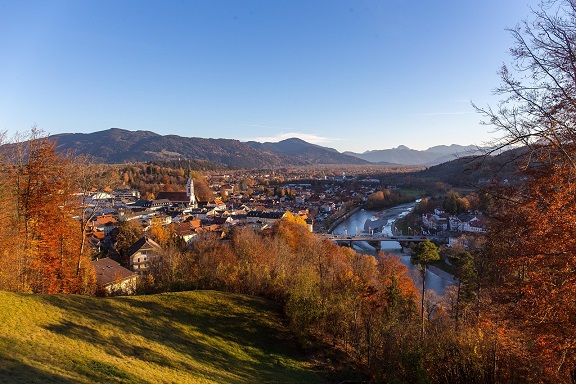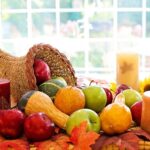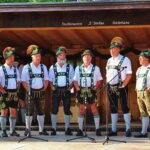
As the leaves turn to vibrant shades of crimson and gold, and a crisp chill descends upon the landscape, Germans welcome the season with a profound sense of warmth and tradition. Autumn in Germany is more than a mere transition from summer’s heat to winter’s frost; it is a time of reflection, celebration, and communal gratitude deeply rooted in the nation’s agrarian past. From the bustling streets of Munich during Oktoberfest to the quiet lantern processions in rural villages, Germans embrace autumn in Germany through rituals that honor the harvest, foster community bonds, and connect generations to their heritage. This article delves into the rich tapestry of German fall traditions, offering insights into their historical origins, regional variations, and modern expressions, inviting readers to discover why this season holds such enduring appeal.
The Historical Significance of Autumn in Germany
Autumn in Germany has long been intertwined with the rhythms of agriculture and spirituality, shaping cultural practices that endure to this day. In pre-Christian times, Germanic tribes marked the autumnal equinox around September 22 as a pivotal moment, when day and night balanced, signaling the end of the growing season. These ancient peoples held harvest rites to appease deities like Freyja, goddess of fertility, ensuring protection through the harsh winter months. Archaeological findings from sites in Lower Saxony reveal evidence of communal feasts and bonfires, precursors to modern festivals.
With the spread of Christianity in the early Middle Ages, these pagan customs were adapted into religious observances. The Catholic Church aligned harvest thanksgivings with Michaelmas on September 29, honoring the archangel as a protector of farmers. Medieval chronicles describe villagers decorating churches with sheaves of grain and fruits, a practice that evolved into Erntedankfest, Germany’s harvest festival typically celebrated on the first Sunday in October. The Reformation in the 16th century further influenced these traditions, with Protestant regions emphasizing communal gratitude over saintly veneration, while Catholic areas retained elaborate processions.
The 19th century’s Romantic movement romanticized autumn as a symbol of melancholy beauty and national identity, inspiring poets like Goethe to weave seasonal motifs into literature. Industrialization brought changes, as urban dwellers sought rural escapes, popularizing hiking and foliage viewing. Post-World War II, autumn traditions gained renewed importance in rebuilding community spirit, with events like German Unity Day on October 3 commemorating reunification in 1990 through speeches, concerts, and fireworks. This historical layering makes autumn in Germany a bridge between ancient folklore and contemporary life, where each custom tells a story of resilience and renewal.
Key Festivals Celebrating Autumn in Germany
Festivals form the heartbeat of how Germans embrace autumn in Germany, transforming the season into a vibrant mosaic of joy and reflection. These events, often tied to the harvest, draw locals and visitors alike into shared experiences that highlight regional pride and cultural depth.
Erntedankfest: Germany’s Harvest Thanksgiving
At the core of autumn in Germany is Erntedankfest, a festival of gratitude for the year’s bounty, observed primarily in rural communities. Churches become canvases of abundance, adorned with intricate displays of wheat crowns, pumpkins, apples, and vegetables, symbolizing stewardship of the land. Services feature hymns and sermons on thankfulness, followed by communal feasts of seasonal dishes like roast goose and fresh bread. In regions like Bavaria, parades with decorated wagons showcase local produce, echoing medieval market traditions.
This festival’s roots lie in pre-Christian harvest rites, Christianized in the 19th century by Protestant churches to promote moral values. Today, it adapts to modern concerns, with some communities focusing on sustainable farming and environmental awareness. For a deeper dive, our article on The Magic of German Harvest Festivals (Erntedankfest) explores its regional nuances.
Oktoberfest: The World’s Largest Beer Festival
No exploration of autumn in Germany would be complete without Oktoberfest, the iconic Munich event that runs from mid-September to early October. Originating in 1810 as a royal wedding celebration for Crown Prince Ludwig, it has grown into a global phenomenon attracting over six million visitors annually. Massive tents serve Maß (liter) steins of beer brewed to the Reinheitsgebot purity law, paired with pretzels, sausages, and roasted chicken.
Beyond the revelry, Oktoberfest reflects Bavarian heritage through traditional attire like dirndls and lederhosen, brass band music, and folk dances. It coincides with the autumn equinox, blending harvest cheer with communal bonding. Smaller Volksfests across Germany offer similar vibes on a local scale, making it accessible beyond Munich.
Martinstag: Lanterns and Legends
As autumn deepens, Martinstag on November 11 honors St. Martin of Tours, a Roman soldier who shared his cloak with a beggar. In Germany, this day features children’s lantern processions, or Laternenumzüge, where handmade paper lanterns illuminate the night, symbolizing the spread of light and kindness. Families sing songs like “Laterne, Laterne” and enjoy roast goose dinners, a nod to the saint’s legend involving hidden birds.
This tradition, popular in Catholic regions, traces to medieval bonfires marking the end of the agricultural year. In Protestant areas, it aligns with Martin Luther‘s birthday, adding layers of religious significance. The lantern walks foster a sense of wonder, teaching values of charity amid the darkening days.
For those interested in quieter observances, our piece on Germany’s Quietest Holiday: What’s So Special About Allerheiligen? complements this with insights into early November’s solemnity.
Outdoor Pursuits in Autumn in Germany
Autumn in Germany invites exploration of the natural world, where the changing foliage creates a painterly backdrop for activities that reconnect people with the environment. The season’s mild weather and scenic beauty make it ideal for outdoor adventures rooted in historical practices.
Hiking Through Golden Forests
Germans cherish Wandern, or hiking, as a way to embrace autumn’s splendor. Trails like the Romantic Road or the Black Forest paths burst with color, offering routes for all levels. This custom dates to the 19th-century Wandervogel movement, which promoted youth exploration of nature as a counter to industrialization. Families pack picnics of cheese, bread, and apples, stopping at huts for warm cider.
In regions like the Harz Mountains, folklore adds enchantment – tales of witches and woodland spirits from the Brothers Grimm enhance the experience. Modern apps guide hikes, but the essence remains: a mindful communion with the land.
Pumpkin and Apple Harvesting
Visiting pumpkin festivals, or Kürbisfeste, is a beloved autumn activity, especially in Baden-Württemberg, where massive gourds are carved into sculptures. These events, inspired by American Halloween but adapted locally, include contests and markets selling pumpkin soups and pies.
Apple picking in orchards along the Mosel River ties into wine traditions, with fresh-pressed juice and strudels celebrating the fruit’s abundance. These hands-on pursuits echo medieval harvest labors, now recreational, fostering appreciation for seasonal cycles.
Our article on Winter Walks and Waldspaziergang extends this theme into colder months.
Culinary Delights of German Fall Traditions
Food plays a starring role in how Germans embrace autumn, with dishes that warm the body and evoke nostalgia. Seasonal ingredients take center stage, blending hearty flavors with historical recipes.
Federweisser, a young fizzy wine, pairs with Zwiebelkuchen (onion tart) during wine festivals, a tradition from the Rhineland’s grape harvest. Wild game like venison stews reflect hunting customs from feudal times, while mushroom foraging yields creamy sauces.
Sweet treats include Pflaumenkuchen (plum cake) and roasted chestnuts sold at markets. These foods not only sustain through cooler days but also preserve family recipes, passed down as cultural heirlooms. For vinous explorations, see Wine Festivals in Germany.
Folklore and Superstitions Surrounding Autumn in Germany
Autumn folklore in Germany weaves tales of mystery and magic, influencing customs that add depth to the season. Stories of the Wild Hunt, a spectral procession led by Odin, warn of stormy nights, rooted in pagan myths. Superstitions like avoiding black cats or hanging rowan branches for protection persist in rural areas.
These narratives, collected by the Grimm brothers, enrich festivals with storytelling sessions. They remind Germans of nature’s unpredictability, blending fear with fascination in a way that captivates all ages.
Modern Interpretations of Autumn in Germany
In contemporary Germany, autumn traditions evolve with societal changes, incorporating sustainability and inclusivity. Eco-friendly festivals use biodegradable decorations, while urban events in Berlin fuse global influences, like multicultural harvest markets.
Younger generations embrace mindfulness practices, such as forest bathing amid fall colors, adapting Wandervogel ideals to wellness trends. Social media amplifies these customs, sharing lantern crafts or hike photos, ensuring their vitality.
This blend keeps autumn in Germany relevant, honoring history while embracing the future.
Planning Your Autumn Journey in Germany
For visitors eager to experience how Germans embrace autumn in Germany, timing is key – September to November offers peak foliage and events. Start in Munich for Oktoberfest, then venture to the Rhine for wine tastings or the Alps for hikes.
Pack layers for variable weather, and book accommodations early near festivals. Public transport eases travel, with regional passes covering scenic routes. Engage locals for authentic tips, perhaps joining a lantern walk or harvest meal.
Combine with summer’s end vibes from Summer in Germany: Lakes, Beer Gardens, and Open-Air Cinemas or midsummer echoes in Germany’s Summer Solstice Celebrations.
The Timeless Charm of Autumn in Germany
Autumn in Germany captivates with its blend of nostalgia and vitality, where traditions foster a deep connection to the land and each other. As a cultural historian, I’ve witnessed how these practices sustain identity in a changing world, offering solace and celebration. Whether through a flickering lantern or a shared stein, this season invites all to partake in its golden embrace.
Related Topics:
To explore more of Germany’s seasonal and regional celebrations, consider these topics:
- The Magic of German Harvest Festivals (Erntedankfest): Uncover the vibrant rituals of thanksgiving.
- Germany’s Quietest Holiday: What’s So Special About Allerheiligen?: Delve into solemn November reflections.
- Germany’s Summer Solstice Celebrations: Experience midsummer’s fiery magic.
- What to Expect at a German Village Fest (Dorf Fest): Join rural community gatherings.
- Wine Festivals in Germany: Toast to vinicultural heritage.
- Summer in Germany: Lakes, Beer Gardens, and Open-Air Cinemas: Relish leisurely warm-weather pursuits.
- The Culture of German Christmas Baking: Savor sweet holiday customs.
- Winter Walks and Waldspaziergang: Wander through serene forests.







